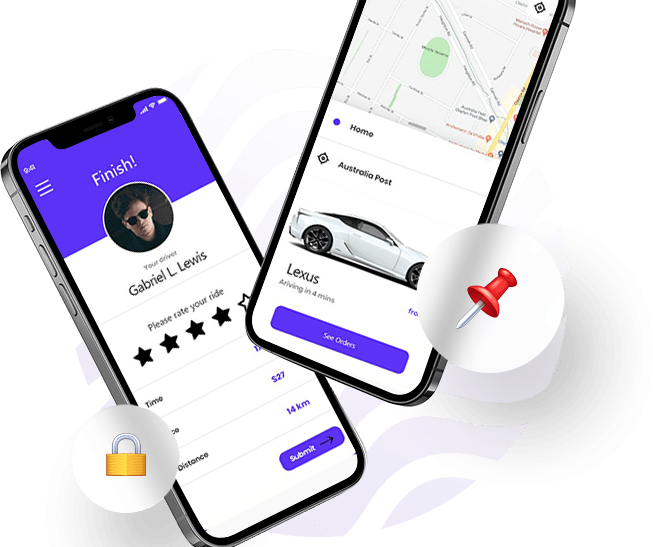In the fast-changing world of ride-hailing services, technology is the engine that propels innovation, consumer happiness, and corporate success. Taxi apps, like their worldwide equivalents Uber and Lyft, rely significantly on cutting-edge technologies to maintain seamless operations, improve the customer experience, and give competitive advantages in a crowded marketplace. However, integrating advanced technologies comes at a cost, which can significantly affect the overall expense of building and operating a taxi app.
In this thorough blog post, we will explore how advanced technologies affect the taxi app development cost and operation. We’ll cover crucial technologies like AI, machine learning, blockchain, IoT, 5G, and more, and analyze their effects on different aspects of a taxi app.
The Impact of Advanced Technologies on Taxi App Costs
The cost of developing a taxi app can vary widely depending on factors such as app complexity, platform choice (iOS, Android, or both), and geographical location. However, one of the most significant factors influencing cost is the integration of advanced technologies. Here’s how some of the most impactful technologies contribute to the overall cost.
1. Artificial Intelligence (AI) and Machine Learning (ML)
Impact on Cost: High
Artificial intelligence and machine learning are among the most expensive technologies to integrate into a taxi app. These technologies are essential for optimizing various functionalities such as:
- Demand Prediction and Dynamic Pricing: AI and ML algorithms help predict demand fluctuations based on historical data, weather conditions, and local events. This feature enables dynamic pricing, which adjusts fares according to demand, maximizing revenue for the business while maintaining customer satisfaction.
- Driver and Route Optimization: AI algorithms can analyze real-time traffic data, road conditions, and driver availability to recommend the best routes, reducing fuel consumption and improving customer satisfaction through faster rides.
- Fraud Detection: ML models can identify patterns indicative of fraudulent behavior, such as fake rides or payment fraud, thereby securing the platform and maintaining user trust.
However, integrating AI and ML requires hiring skilled data scientists, developing complex algorithms, and maintaining large datasets, all of which drive up costs.
Development Cost Considerations:
- AI/ML model development and training
- Data collection and preprocessing
- Integration with the app’s backend
- Continuous model updates and optimization
- Cloud storage and processing costs
2. Internet of Things (IoT)
Impact on Cost: Moderate to High
IoT integration in taxi apps can significantly enhance the functionality of the platform. IoT-enabled devices, such as smart sensors and connected vehicles, provide real-time data that can be used for various applications:
- Vehicle Tracking and Monitoring: Real-time tracking of vehicles using GPS and IoT sensors improves fleet management and enhances safety. IoT also enables monitoring vehicle health, such as engine performance, tire pressure, and fuel levels, which can prevent breakdowns and reduce maintenance costs.
- In-Car Services: IoT can be used to offer in-car services, such as Wi-Fi, entertainment systems, or climate control, providing passengers with a more comfortable and connected experience.
While IoT offers numerous advantages, integrating it into a taxi app can be costly. Developers need to build the necessary infrastructure, such as APIs for communication between the app and IoT devices, which requires expertise in both software and hardware development.
Development Cost Considerations:
- Hardware and sensor costs
- API and middleware development
- Real-time data processing
- Security and privacy measures
- Ongoing maintenance and upgrades
3. Blockchain Technology
Impact on Cost: High
Blockchain technology has been making inroads into the taxi app industry, primarily for ensuring secure, transparent, and tamper-proof transactions. Blockchain can be used in the following areas:
- Payment Systems: Blockchain can facilitate decentralized, secure, and fast payments between drivers and passengers, reducing the reliance on traditional payment processors and lowering transaction fees.
- Data Security: Blockchain provides an additional layer of security for sensitive user data, such as personal information and ride histories, by encrypting and decentralizing the storage of this data.
- Smart Contracts: Blockchain-based smart contracts can be used to automate agreements between drivers, passengers, and the platform, ensuring that payments and other obligations are fulfilled automatically once certain conditions are met.
However, blockchain development is complex and resource-intensive, requiring specialized developers and higher operational costs. Additionally, integrating blockchain with existing systems can be a challenging process, further increasing costs.
Development Cost Considerations:
- Blockchain platform development
- Smart contract programming
- Decentralized storage solutions
- Transaction fee management
- Continuous monitoring and security audits
4. 5G Technology
Impact on Cost: Moderate to High
With the rollout of 5G networks, taxi apps are set to benefit from faster and more reliable connectivity. 5G technology enables:
- Real-Time Data Processing: 5G allows for the instantaneous transfer of large volumes of data, which is crucial for real-time features like live tracking, dynamic route optimization, and in-car entertainment.
- Enhanced User Experience: Faster internet speeds translate to better user experiences, such as quicker app loading times, smoother ride-booking processes, and real-time notifications.
- Connected Vehicles: 5G supports connected vehicles, enabling advanced driver-assistance systems (ADAS) and autonomous driving features, which can be integrated into future taxi app models.
While the benefits of 5G are clear, implementing this technology requires upgrading existing infrastructure and ensuring that the app is compatible with 5G networks. This can increase the cost of development, especially in the early stages of 5G adoption.
Development Cost Considerations:
- Network infrastructure upgrades
- Optimization for 5G compatibility
- Testing in 5G environments
- Device compatibility and support
- Continuous app updates for emerging 5G features
5. Augmented Reality (AR) and Virtual Reality (VR)
Impact on Cost: Moderate to High
AR and VR technologies are becoming increasingly popular in the ride-hailing industry, offering new ways to engage users and improve their experience. Some applications include:
- Virtual Ride-Previews: VR can provide users with a virtual preview of their ride, allowing them to see the route, estimated time of arrival, and even the vehicle’s condition before they get in.
- AR Navigation: AR can enhance navigation for both drivers and passengers by overlaying directions on the real-world view, making it easier to follow routes and locate pickup or drop-off points.
- Immersive In-Car Experiences: AR and VR can be used to offer immersive in-car experiences, such as virtual tours, entertainment, and interactive advertising.
While these features can set a taxi app apart from competitors, developing AR and VR content is resource-intensive and requires specialized expertise. The development cost will depend on the complexity of the AR/VR features and the level of immersion offered.
Development Cost Considerations:
- AR/VR content creation
- App integration and compatibility
- Hardware support (e.g., AR-enabled smartphones or VR headsets)
- User interface and experience design
- Ongoing content updates and maintenance
6. Cloud Computing and Big Data Analytics
Impact on Cost: Moderate
Cloud computing and big data analytics are essential for handling the massive amounts of data generated by a taxi app. Cloud-based services offer scalability, flexibility, and cost savings by reducing the need for on-premise infrastructure. Key applications include:
- Data Storage: Cloud storage solutions allow taxi apps to store large volumes of data, such as user profiles, ride histories, and payment information, without the need for expensive on-premise servers.
- Data Analytics: Big data analytics provides valuable insights into customer behavior, ride patterns, and operational efficiency, enabling data-driven decision-making and personalized services.
- Scalability: Cloud services allow taxi apps to scale operations quickly and efficiently, handling increased demand during peak hours or expanding to new regions without significant upfront costs.
While cloud computing offers many cost-saving benefits, integrating these services into a taxi app requires a robust backend infrastructure and ongoing subscription fees, which can add to the overall cost.
Development Cost Considerations:
- Cloud service provider fees (e.g., AWS, Google Cloud)
- Backend infrastructure development
- Data analytics platform integration
- Security and compliance measures
- Ongoing monitoring and optimization
Cost Breakdown of Advanced Technology Integration
To provide a clearer picture of how advanced technologies affect the cost of taxi apps, here is a cost breakdown based on different stages of development:
1. Initial Development Costs:
- Research and Planning: $5,000 – $20,000
- UI/UX Design: $10,000 – $30,000
- Backend and API Development: $50,000 – $150,000 (depending on cloud, AI, IoT integration)
- Frontend Development: $30,000 – $100,000
2. Technology-Specific Costs:
- AI/ML Integration: $50,000 – $200,000 (for features like predictive analytics and route optimization)
- IoT Implementation: $30,000 – $150,000 (hardware, sensor integration, and real-time tracking)
- Blockchain Integration: $50,000 – $200,000 (for secure payments and data storage)
- 5G Optimization: $20,000 – $50,000 (network infrastructure and compatibility testing)
- AR/VR Features: $50,000 – $150,000 (content creation and app integration)
3. Ongoing Costs:
- Cloud Storage and Computing: $5,000 – $30,000 per month
- Data Analytics and AI Model Updates: $10,000 – $50,000 per year
- Security and Compliance: $10,000 – $50,000 per year
- Maintenance and Updates: $20,000 – $100,000 per year
Conclusion: Balancing Cost with Innovation
Incorporating advanced technologies into a taxi app can significantly improve its functionality, user experience, and competitiveness. However, these benefits come with higher costs that must be properly controlled. To strike the right balance between innovation and funding, it’s essential to prioritize technologies that provide the greatest value to your business and users.
For startups and small enterprises, it may be prudent to begin with a minimal viable product (MVP) that includes basic functions, then gradually incorporate more advanced technologies as the business expands. Established companies, on the other hand, may opt to spend extensively on cutting-edge technologies to remain ahead of the competition and provide distinctive benefits.
Ultimately, the key to success lies in understanding your target market, aligning technology investments with business goals, and planning for the long-term costs associated with advanced technology integration. By doing so, you can create taxi app that not only matches user expectations but also delivers a sustainable and profitable business model.
Feel free to submit more guest posts through Links Building Servcies - Best Prices. Buy Author Account / 1$ Guest Post Here




![How to transfer money from Robinhood to bank account? [Steps]](https://hollywoodrag.com/wp-content/uploads/2024/08/Banking-Across-Europe.jpg)


















